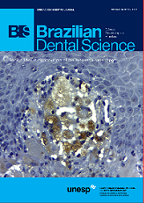Calcium Hydroxide improves epoxy sealer adhesion on root dentin
DOI:
https://doi.org/10.14295/bds.2017.v20i2.1400Abstract
Objective: The aim of this study is to evaluate the adhesion of an endodontic sealer (AHPlus in root canals after the use of different protocols of 17% EDTA and the use of intracanal medication (ICM) based on calcium hydroxide in aqueous vehicle. Material and Methods: For this, 72 single-rooted human teeth were instrumented up to #50 and divided into six groups (n = 12). Group 1: EDTA for 3 min; Group 2: 3 mL of EDTA + 3 min of EDTA; Group 3: 3 mL of EDTA + 3 min of EDTA + 30 seconds of ultrasonic agitation; Group 4: EDTA for 3 min + ICM; Group 5: 3 mL of EDTA + 3 min of EDTA + ICM; Group 6: 3 mL of EDTA + 3 min of EDTA + 30 seconds of ultrasonic agitation + ICM. The root canals were filled with endodontic sealer after each protocol and after 7 days they were prepared to the push-out test. The data were analyzed using ANOVA two factors (p < 0.05). Results: It was observed no statistically difference in bond strength in the 3 different 17% EDTA protocols. However, the use of ICM increased significantly the resistance adhesion. Conclusion: Intracanal medication based on calcium hydroxide improved the bond strength of AHPlus to dentin walls, regardless of the EDTA protocol.
Keywords
Calcium hydroxide; EDTA; Dentin.
Downloads
Downloads
Published
How to Cite
Issue
Section
License
Brazilian Dental Science uses the Creative Commons (CC-BY 4.0) license, thus preserving the integrity of articles in an open access environment. The journal allows the author to retain publishing rights without restrictions.
=================




























